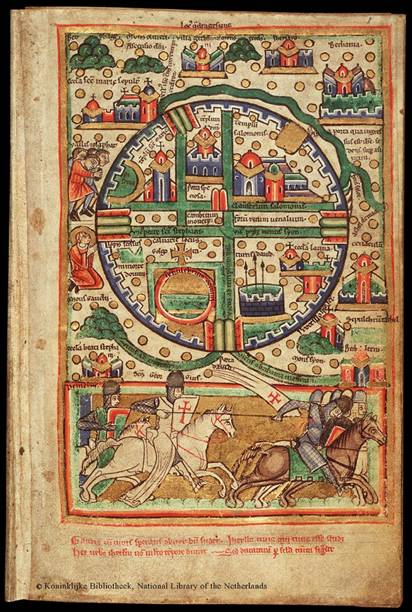NEH Holy Land
Holy Land and Holy City in
Classical Judaism, Christianity, and Islam
NEH Summer Institute
July 9-August 12, 2008
Oxford, England

Map of Jerusalem, ca. AD 1200 (copyright permission; The Hague, Koninklijke Bibliotheek, 76 F 5
Narrative Description:
The American philosopher Arthur O. Lovejoy inquired, "Can a proposition about the happening of a particular incident at a certain time in a little corner of the earth really be one of the fundamental verities which every man ought to know and believe for his soul's health?" To his mind, the enduring attachment of Western religious traditions to the geographical area between the Mediterranean Sea and the Jordan River—whether one calls it Canaan, Judea, Israel, Coele-Syria, Palestine, Eretz Israel, Zion, or Holy Land—was unfathomable and unwarranted. Yet despite Lovejoy's sarcasm, the Holy Land assumed a central importance in each of the three monotheistic religions born in the Middle East, viz. Judaism, Christianity, and Islam, that has extended far beyond theology and ceremony. Engulfed in geopolitical, military, and ethnic conflicts that rarely seem to abate, the land continues to dominate the attention of politicians, journalists, theologians, and cultural critics in all corners of the world—far beyond the extent that its physical and demographic dimensions might lead one to expect.
Holy Land and Holy City in Classical Judaism, Christianity, and Islam, a five-week NEH summer institute for college faculty, will investigate the significance of the Holy Land (and the holiest of its cities, Jerusalem, in particular) in classical Judaism, Christianity, and Islam in late antiquity and the Middle Ages. While adopting a broad perspective that will include theological, geographical, and anthropological aspects of that significance, we shall focus above all on the conjunction of physical space, ideas, and cultural praxis that gave expression to the holiness of the land, as it was perceived by adherents of the three religions.
